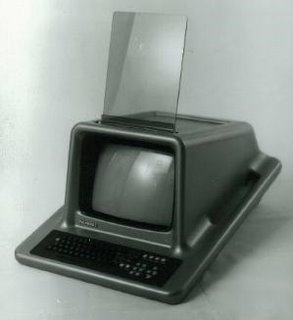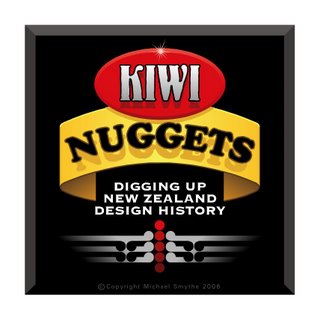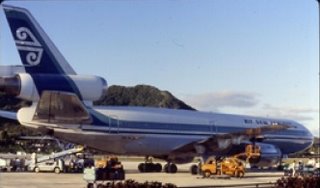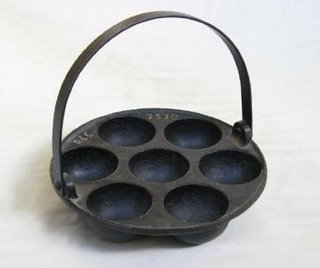
The full text of this story Promising Polycorp pipped can be found in PRODESIGN 86, Dec 2006 /Jan 2007, p.86.
The Poly1 Computer, discovered at Motat, attracted immediate attention because of its physical presence and well resolved form. The story behind it exemplifies the fate of state-supported Kiwi leadership at a time of economic revolution. What we know:
In 1980 a niche market in the education sector was recognised by Neil Scott and Paul Bryant of the Wellington Polytechnic School of Physics, Electronics, Telecommunications and Electrical Engineering. They successfully pitched a concept to the Minister of Education, Merv Wellington.
Scott was assigned to the project full-time and worked with a development team of about six engineers and technicians. 50 working prototypes were built in eight months using the leading-edge technology of the time. The Poly1 began with 64 kilobytes of memory (four times the maximum available on an Apple II) and a video card so that video was overlaid with graphics on a Philips 14” colour television monitor.
The government’s Development Finance Corporation partnered with Perce Harpham’s Lower Hutt company, Progeni Computers, to form Polycorp which took over the design of the operating system and post-prototype production. Progeni’s customised version of the Motorola OS9 microchip had 32 bit addressing (Intel were offering only 8bit addressing). The software become a world-leading product in its own right.
At the Education Department Kevin Hearle managed the production of computer-friendly course material for which Polycorp became the agents. Sixty teachers worked through the 1980-81 summer holiday to write course content into ‘shells’ created in the software. Polycorp presented their product as a reliable, robust, networked, teacher and student-friendly closed system specifically designed to deliver computer assisted learning across curricula as well as computer awareness, computer studies and support for school administration.
The Design School at Wellington Polytechnic was brought into the project to encase and express the qualities of this unique product. Tutors Mark Pennington, Gerry Luhman and others addressed performance criteria including resilience, reliability, accessibility and simplicity. The optimum slope of the keyboard was extended to float the box off the desk while providing carry handles. Placing the parting line on this slope allowed for a rolled edge at the top of the screen without creating a complex moulding. The GRP casings were to be made in a range of six colours (easily achieved with different gel coats) so that each student would relate to ‘their’ unit. The internal assembly facilitated easy repair and upgrading. It had functionality and ‘X factor’.
The Poly1 was superseded by the Poly2 which used a boring, beige off-the-shelf box to house what was still a differentiated evolving system.
The Poly computer was at least eighteen months ahead of the Acorn BBC Micro computer that eventually dominated the education sector in the UK and elsewhere (having been developed and promoted with the involvement of government institutions). What went wrong?
Kiwi can-do cooperation is matched only by our cruel capacity for clobbering. The fledgling micro-computer industry set about building its market base for imported PCs by bad-mouthing bureaucrats and boffins for denying it rightful access to the state education sector. A low blow was landed when someone claimed that an early working title, ‘Polywog’ (as in tadpole), was racist.
By late 1981 when the market-ready Poly1 had completed field trials, the National government had scraped back with a one-seat majority. Behind the scenes right-wing interests were beginning to decree that government participation in the business world was not politically correct. The Government succumbed to lobbying and reneged on its purchase agreement for 1000 Polys per year for five years. Cabinet minister Warren Cooper told Perce Harpham that he and his colleagues "could see no reason why Government should spend money so that teachers could do even less work." A story soon surfaced concerning one US computer company’s New Zealand operation being headed by someone who had been a senior National minister’s campaign manager and that another ex-minister, then representing New Zealand abroad, was a major stakeholder.
Several thousand Poly1 units were sold, but the base New Zealand market evaporated when each school was given a free Apple II computer and offered more at 25% retail price. Progeni picked itself up and pressed on. They won a contract, against 42 contenders, to supply the Australian Army. The long process of establishing a market in China began with Progeni achieving another ‘world-first’ by developing a separate graphics processor for Chinese characters. Initial success was interrupted by the 1989 Tiananmen Square massacre.
The DFC was declared insolvent and stopped trading in late 1989 so Progeni was on its own. About a year later, just as the Vice President of the Agricultural Bank of China (1.4 million employees and 40,000 branches) signed a letter of understanding to use Poly2s exclusively for their educational needs, the Bank of New Zealand placed Progeni in receivership. Like many businesses unable to meet demands for immediate cash to bail out the BNZ at its time of crisis, Progeni was liquidated.
What we would like to know:
Anything that expands on this story.
The whereabouts of any Poly1 Computers now.




